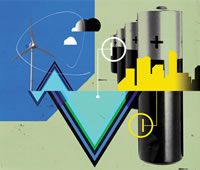Batteries Need to Get Big—Like, Enormous—for Solar Power to Shine
 Vaclav Smil for IEEE Spectrum: It would be a lot easier to expand our use of solar and wind energy if we had better ways to store the large quantities of electricity we’d need to cover gaps in the flow of that energy.
Vaclav Smil for IEEE Spectrum: It would be a lot easier to expand our use of solar and wind energy if we had better ways to store the large quantities of electricity we’d need to cover gaps in the flow of that energy.
Even in sunny Los Angeles, a typical house roofed with enough photovoltaic panels to meet its average needs would still face daily shortfalls of up to about 80 percent of the demand in January and daily surpluses of up to 65 percent in May. You can take such a house off the grid only by installing a voluminous and expensive assembly of lithium-ion batteries. But even a small national grid—one handling 10 to 30 gigawatts—could rely entirely on intermittent sources only if it had gigawatt-scale storage capable of working for many hours.
Since 2007, more than half of humanity has lived in urban areas, and by 2050 more than 6.3 billion people will live [PDF] in cities, accounting for two-thirds of the global population, with a rising share in megacities of more than 10 million people. Cont'd...
Comments (0)
This post does not have any comments. Be the first to leave a comment below.
Featured Product

